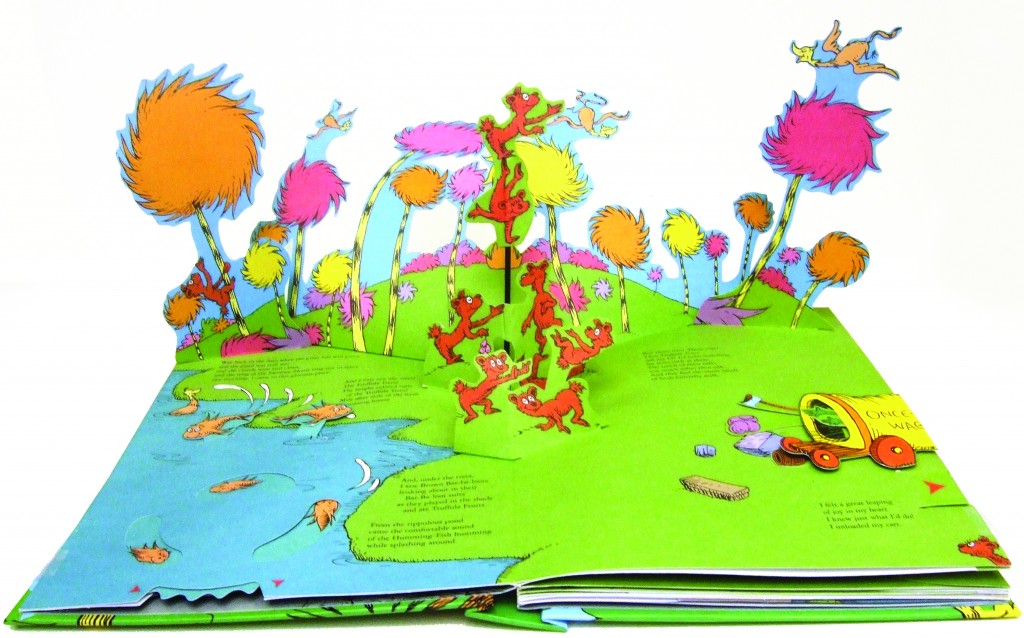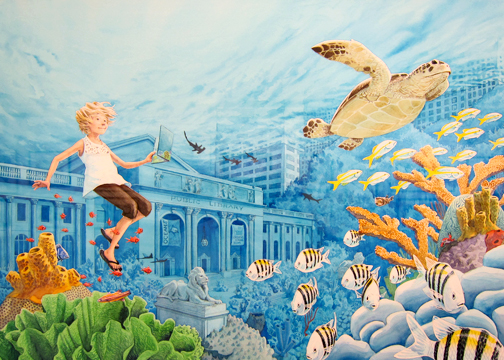We've curated a list of some truly wonderful and entertaining bug books for kids ages 4 to 99. We've also included the game Bug Bingo, and it's the bees-knees.
Add a CommentViewing: Blog Posts Tagged with: Environment &, Most Recent at Top [Help]
Results 1 - 22 of 22
Blog: The Children's Book Review (Login to Add to MyJacketFlap)
JacketFlap tags: Ages 4-8, Ages 9-12, Book Lists, Nature, Science, Butterflies, Bugs, featured, DK Publishing, Animal Books, National Geographic Children's Books, Nature Studies, Sterling Children's Books, Environment & Ecology, Detective Books, Bugs & Spiders, Princeton Architectural Press, Nancy Honovich, Backyard Books, Books About Flies, Charlotte Caldwell, Christine Berrie, Darlyne Murawski, Kathrina Iris, Maggie Li, Rachel Elizabeth Cole, Tangled Oak Press, University of South Carolina Press, Add a tag
Blog: The Children's Book Review (Login to Add to MyJacketFlap)
JacketFlap tags: featured, Boyds Mills Press, Geology, Animal Books, Nature Studies, Environment & Ecology, Speed Interview, Daniel Levitin, Donald Kroodsma, Jeff Sayre, Kenn Kaufman, Kim Kaufman, Liz Cunningham, Ages 4-8, Ages 9-12, Science, Chapter Books, Author Interviews, April Pulley Sayre, Add a tag
Which five words best describe The Slowest Book Ever? April Pulley Sayre: Chewy science for wondrous pondering.
Add a CommentBlog: The Children's Book Review (Login to Add to MyJacketFlap)
JacketFlap tags: Ages 4-8, Adventure, Ages 9-12, Chapter Books, Australia, Books for Boys, Australian, Environment & Ecology, Mystery, featured, Australian Authors, Danny Pinn, Julian Ledlin, Mysteries, Add a tag
Complete with bush walks and a vegemite sandwich, Johnny Foolish is an Australian tale worthy of a read—too right!
Add a CommentBlog: The Children's Book Review (Login to Add to MyJacketFlap)
JacketFlap tags: Ages 9-12, Science, Chapter Books, Zoo, Zoology, Animal Books, Environment & Ecology, Jess Keating, Sourcebooks Jabberwocky, My Life is a Zoo Series, Selfie and a Shelfie, Add a tag
How to Outfox Your Friends When You Don’t Have a Clue is the third book in the ‘My Life is a Zoo” series written by Jess Keating.
Add a CommentBlog: The Children's Book Review (Login to Add to MyJacketFlap)
JacketFlap tags: Ages 4-8, Ages 9-12, Winter, Picture Books, Snow, Nature, Science, featured, Animal Books, Winslow Homer, Jim Arnosky, Roger Tory Peterson, Audubon, Nature Studies, Seasonal: Holiday Books, Illustration Inspiration, Sterling Children's Books, Environment & Ecology, Polar Animals, Natural History Books, Bob Kuhn, Bruno Liljefors, Charles Tunnicliffe, Add a tag
Artist and naturalist Jim Arnosky has been honored for his overall contribution to literature for children by the Eva L. Gordon Award and the Washington Post/Children’s Book Guild Award for nonfiction. His latest book is "Frozen Wild."
Add a CommentBlog: The Children's Book Review (Login to Add to MyJacketFlap)
JacketFlap tags: Ages 4-8, Ages 9-12, Picture Books, Nature, Current Affairs, Trees, Author Showcase, Environment & Ecology, J. Steven Spires, Jonathan Caron, Booka About Natural Disasters, Hurricane Books, Add a tag
In The Oak Tree, written by J. Steven Spires and illustrated by Jonathan Caron, the reader is given the opportunity to revisit the devastation wrought by Hurricanes Katrina and Rita on the Gulf Coast 10 years ago.
Add a CommentBlog: The Children's Book Review (Login to Add to MyJacketFlap)
JacketFlap tags: Travel, Ages 4-8, Ages 9-12, featured, Dover Publications, Activity Books, True Kelley, Animal Books, National Geographic Children's Books, Mordicai Gerstein, Marion Dane Bauer, Gary Robson, Environment & Ecology, Cultural Wisdom, Barb Rosenstock, Erin McHugh, Best Kids Stories, Auzou Books, Black Dog & Leventhal Publishers, Farcountry Press Books, Guide Books, Maud Lienard, Mike Graf, National Parks Books, National Parks Guide Books, Simon Spotlight Books, Yosemite Conservancy Books, Add a tag
For those of you planning to take your kids to a national park in 2015, here are some excellent books you need to take along for the ride.
Add a CommentBlog: The Children's Book Review (Login to Add to MyJacketFlap)
JacketFlap tags: Books for Girls, Animal Books, Girl Detectives, Nature Studies, Environment & Ecology, Out, Detective Books, Pipsie Nature Detective Series, Rick DeDonato, Tracy Bishop, Ages 4-8, Picture Books, Nature, Add a tag
PIPSIE and Alfred solve the mysteries of nature, and show kids how to solve them, too.
Add a CommentBlog: The Children's Book Review (Login to Add to MyJacketFlap)
JacketFlap tags: Ages 4-8, Creativity, Picture Book, Winter, Picture Books, Snow, Weather, Science, Frogs, featured, Animal Books, Russ Cox, Environment & Ecology, Books About Blizzards, Janice Dean, Regnery Kids Books, Add a tag
Freddy the Frogcaster and the Big Blizzard does an excellent job of creating a creative way to get kids interested in learning about the science of weather.
Add a CommentBlog: The Children's Book Review (Login to Add to MyJacketFlap)
JacketFlap tags: Health, Ages 9-12, Birds, Nature, Chapter Books, Suicide, Depression, Wendy Lamb Books, Multiple Sclerosis, Friendships, Nest, Random House Children's Books, Family Relationships, Environment & Ecology, Social Graces, Esther Ehrlich, Cape Cod Books, Orinthology, Add a tag
Esther Ehrlich’s debut novel, Nest, is an arresting story of an eleven-year-old girl named Chirp Orenstein, whose life becomes acutely sharp and complicated as her mother’s illness overtakes the family
Add a CommentBlog: The Children's Book Review (Login to Add to MyJacketFlap)
JacketFlap tags: Illustrator, Ages 4-8, Picture Book, Winter, Picture Books, Snow, Weather, Illustrator Interviews, Author Interviews, featured, Books for Boys, John Rocco, Book Illustrator, Seasonal: Holiday Books, Environment & Ecology, Social Graces, Add a tag
John Rocco discusses his newest picture book, Blizzard, the companion to your Caldecott Honor-winning Blackout.
Add a CommentBlog: The Children's Book Review (Login to Add to MyJacketFlap)
JacketFlap tags: Ages 9-12, Science, Chapter Books, featured, Books for Boys, Oceans, Ocean Science, Animal Books, Environment & Ecology, Ellen Prager, Tristan Hunt and the Sea Guardian series, Add a tag
Ellen Prager, PhD, ocean scientist and author, brings ocean science to the young fiction audience with her Tristan Hunt and the Sea guardian series.
Add a CommentBlog: The Children's Book Review (Login to Add to MyJacketFlap)
JacketFlap tags: Greenwillow Books, Seasonal: Holiday Books, Environment & Ecology, Christie Matheson, Changing Seasons Books, Season Books, Ages 0-3, Ages 4-8, Picture Books, Science, Interactive, Trees, Add a tag
Tap The Magic Tree, by Christie Matheson, is a beautiful story about the changing seasons centered on a single tree that children are asked to interact with on the page.
Add a CommentBlog: The Children's Book Review (Login to Add to MyJacketFlap)
JacketFlap tags: Ages 0-3, Ages 4-8, Picture Book, Picture Books, Book Awards, Gift Books, Wildlife, Award Winners, Tigers, Little Brown Books for Young Readers, Animal Books, Peter Brown, Environment & Ecology, Social Graces, Best Kids Stories, Book Award Winners, Bull-Bransom Award, Add a tag
The Children’s Book Review | May 20, 2014 The National Museum of Wildlife Art in Jackson Hole, Wy, announced that children’s book author/ illustrator Peter Brown is the recipient of the 2014 Bull-Bransom Award for his 2013 picture book Mr. Tiger Goes Wild. The judges called it “an exceptional tribute to the wild and rambunctious energy in all children” and […]
Add a CommentBlog: The Children's Book Review (Login to Add to MyJacketFlap)
JacketFlap tags: Environment & Ecology, Books About Plants, Books About Seeds, Cindy Jenson-Elliott, John Hutton, Ages 0-3, Ages 4-8, Picture Books, Book Lists, Current Affairs, Gardening, featured, Board Books, Water, Melissa Stewart, Earth Day, Picture Books For Children, Lorena Siminovich, Add a tag
I just love that Earth Day is in spring! It makes perfect sense to capture everyone's attention when they are ready to get back into the great outdoors after winter. Below you'll discover just a couple of the books that have caught my attention because of their appreciation of gardens, plants, and even weeds.
Add a CommentBlog: The Children's Book Review (Login to Add to MyJacketFlap)
JacketFlap tags: Ages 9-12, Nature, Chapter Books, Author Interviews, Current Affairs, Coming of Age, featured, Books for Boys, Environmental, Forests, Environment & Ecology, Redwood Trees, Susannah Terrell French, Add a tag
The Children’s Book Review is delighted to welcome Susannah Terrell French to our tree house today. She is an environmental lawyer and the award-winning author of Operation Redwood, a high adventure novel about four determined children who take on big business to save a redwood forest.
Add a CommentBlog: The Children's Book Review (Login to Add to MyJacketFlap)
JacketFlap tags: Wong Herbert Yee, Summer reading, Tim Green, Simon Basher, Vanessa Giancamilli Birch, Donna Freitas, featured, Dan Green, Meilo So, Kate Coombs, Animal Books, Ammi-Joan Paquette, David Shannon, Charles Siebert, Seasonal: Holiday Books, Alton Langford, Molly Baker, Ellen Harasimowicz, Teens: Young Adults, Environment & Ecology, Marie Letourneau, Brenda Peterson, Dr. Frances Dipper, Loree Griffin, Nolan Carlson, Robin Lindsey, Ages 4-8, Ages 9-12, Sports, Baseball, Add a tag
By Nina Schuyler, The Children’s Book Review
Published: June 12, 2012
It’s summertime with its big bowl of a blue sky. Outside becomes another room, with open fields and the whir and buzz of bugs and baseball, and the voice of the water and the touch of sand.
Day One of summer, my son asks, “Now what?” So we ride our bikes to the library and load our backpacks with books about summer. Here’s a list to fill up the baggy pockets of summertime.
Summer and the Outside World
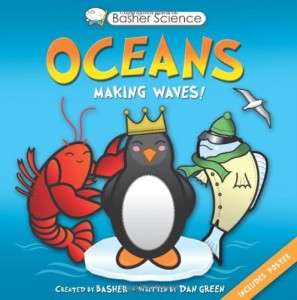 Oceans: Making Waves!
Oceans: Making Waves!
Created by Simon Basher, written by Dan Green and Dr. Frances Dipper
Oceans: Making Waves! created by Simon Basher and written by Dan Green and Dr. Frances Dipper (independent marine consultant) takes kids underwater to discover mountains taller than anything on dry land, and trenches deeper than Mount Everest is high. Green personifies the aspects of the ocean. Here’s the Tide talking: “I’m a bit of a lunatic! As the Moon passes overhead, the water in the ocean feels a tug toward it. That’s gravity. In fact the whole planet feels this force of attraction…” Filled with interesting facts that make you see the world of the ocean with new eyes (the giant kelp grows up to 20 inches (50 cm) per day!)
Ages 10-15 | Publisher: Kingfisher | March 27, 2012
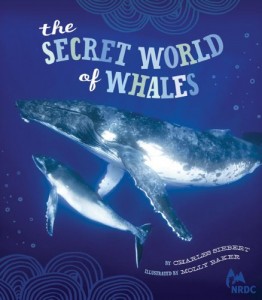 The Secret World of Whales
The Secret World of Whales
By Charles Siebert; illustrated by Molly Baker
You’ll learn in The Secret World of Whales by Charles Siebert, illustrated by Molly Baker that the human brain and the whale brain are surprisingly similar and the sperm whale has the largest brain on earth, weighing more than 19 pounds (8.6 kilograms). Siebert explores the history, legends stories and science of whales. By the end, as the author did, you’ll want to have your own face-to-face encounter with this amazing creature.
Ages 8-12 | Publisher: Chronicle Books | April 20, 2011
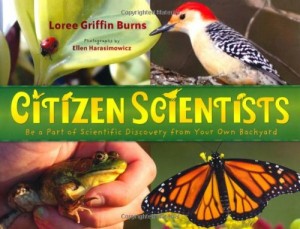 Citizen Scientists
Citizen Scientists
By Loree Griffin Burns; photography by Ellen Harasimowicz
Summer means getting outside and Citizen Scientists by Loree Griffin Burns, photography by Ellen Harasimowicz shows you how to engage with the natural world in a scientific way. You’ll discover how to capture and tag a Monarch butterfly without damaging its wings, and you’ll learn to distinguish be
Add a CommentBlog: The Children's Book Review (Login to Add to MyJacketFlap)
JacketFlap tags: Book Lists, Science, featured, Board Books, Animal Books, Smithsonian Institute, Environment & Ecology, Ages 0-3, Add a tag
By Nina Schuyler, The Children’s Book Review
Published: May 21, 2012
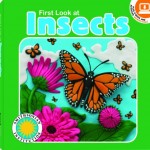 After reading so many books with talking bunnies and dogs, of mice that look cuddly and sweet, of mischievous cats and raccoons, it’s a relief, of sorts, to enter the world of realism, especially one that has the stamp of the prestigious Smithsonian Institution. The realism comes if not through the photographs, then through the information.
After reading so many books with talking bunnies and dogs, of mice that look cuddly and sweet, of mischievous cats and raccoons, it’s a relief, of sorts, to enter the world of realism, especially one that has the stamp of the prestigious Smithsonian Institution. The realism comes if not through the photographs, then through the information.
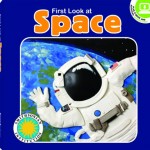 In the “First Look” series of board books, published by Soundprints, you find out in “First Look at Insects,” that the praying mantis uses her long back legs to catch a snack and that a dragonfly can fly forward, sideways, and even backward. In “First Look at Space,” you get to learn about the solar system, the sun and the Milky Way. And in “First Look at Dinosaurs,” you begin the long journey of learning the correct pronunciation of dinosaurs, in addition to finding out about the dinosaurs’ myriad defense apparatuses—horns, club tails and big teeth. With the purchase of these books, you’re entitled to download an e-book and also printable activities, such as making your own insect out of an egg carton or creating your own bug dessert with chocolate pudding.
In the “First Look” series of board books, published by Soundprints, you find out in “First Look at Insects,” that the praying mantis uses her long back legs to catch a snack and that a dragonfly can fly forward, sideways, and even backward. In “First Look at Space,” you get to learn about the solar system, the sun and the Milky Way. And in “First Look at Dinosaurs,” you begin the long journey of learning the correct pronunciation of dinosaurs, in addition to finding out about the dinosaurs’ myriad defense apparatuses—horns, club tails and big teeth. With the purchase of these books, you’re entitled to download an e-book and also printable activities, such as making your own insect out of an egg carton or creating your own bug dessert with chocolate pudding.
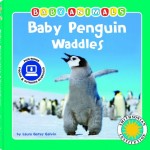 In the “Baby Animals” series, published by Soundprints, you are treated to wonderful photographs of different animals—in “Baby Penguin Waddles,” “Lion Cub Roars,” and “Fawn and her Family,” the sentences are simple and relate to the photograph. These books, too, come with activities and e-books to download.
In the “Baby Animals” series, published by Soundprints, you are treated to wonderful photographs of different animals—in “Baby Penguin Waddles,” “Lion Cub Roars,” and “Fawn and her Family,” the sentences are simple and relate to the photograph. These books, too, come with activities and e-books to download.
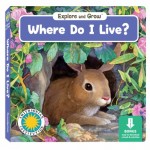 In “Where Do I Live?” you get to play a guessing game. The animal gives you clues, quietly slipping in facts about itself in a rhyme scheme, and you guess the name of its home. For instance, “I am a bumblebee, striped all over. I bring nectar home from a patch of clover. Worker bees live in my home, and it is filled with honeycomb. Where do I live?” Turn the page. “A hive!”
In “Where Do I Live?” you get to play a guessing game. The animal gives you clues, quietly slipping in facts about itself in a rhyme scheme, and you guess the name of its home. For instance, “I am a bumblebee, striped all over. I bring nectar home from a patch of clover. Worker bees live in my home, and it is filled with honeycomb. Where do I live?” Turn the page. “A hive!”
These series are a nice addition to remind you and your little one that these animals, in fact, exist
Add a CommentBlog: The Children's Book Review (Login to Add to MyJacketFlap)
JacketFlap tags: Picture Books, featured, Alison Jay, Earth Day, Patrice Barton, David McPhail, Laura Vaccaro Seeger, Environment & Ecology, Michael Catchpool, Allison Wortche, Ages 4-8, Add a tag
By Bianca Schulze, The Children’s Book Review
Published: April 17, 2012
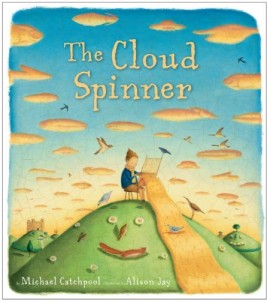 The Cloud Spinner
The Cloud Spinner
By Michael Catchpool; Illustrated by Alison Jay
The Cloud Spinner is, as it’s title suggests, about a boy who makes fine clothes spun from clouds “just as his mother had taught him.” When the greedy King learns of the boy’s talents he demands many outfits be made. Using repetitive and cautionary words, the boy explains over-and-over: “It would not be wise … Your Majesty does not need them.” The clouds eventually disappear and action must be taken. Alison Jay’s signature paintings with the crackle varnish lend themselves well to this clever and fantastical, “green” fairy tale told by Michael Catchpool—the crackling provides an aged feeling of wisdom, while her bright pallet and fanciful placement of animals add a level of freshness that draws young readers in easily. When it comes to delivering a message of conserving resources for our future, a story driven by a child protagonist is the perfect antidote—as gentle as a floating cloud overhead, Catchpool’s tale gives power to the young people!
Ages 5-8 | Publisher: Alfred A. Knopf Books for Young Readers | March 13, 2012
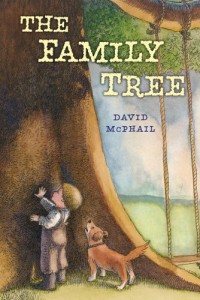 The Family Tree
The Family Tree
By David McPhail
Reminiscent of Shel Silvertein’s The Giving Tree and Virginia Lee Burton’s The Little House, McPhail renders his own little slice of thoughtfulness with The Family Tree. This poignant story about a young boy, who takes a stand to protect one tree from the perils of a new highway ready to be built, reminds all of us that our trees have been here for a very long time, they have seen many things, and they need our protection. The text is direct and the illustrations, which were created using watercolor and ink on illustration board, are sophisticated—both offer the last word in urbanity … a quality fit for this environmental tale.
Ages 4-8 | Publisher: Henry Holt for Young Readers | March 27, 2012
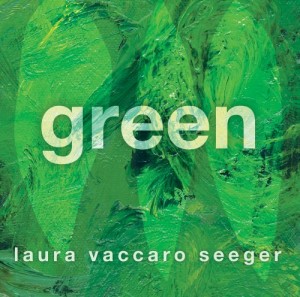 Green
Green
This is a concept book about the color green in representation of all creation, by Laura Vaccaro Seeger (First the Egg—a Caldecott Honor Book and a Geisel Honor Book; One Boy—a Geisel Honor Book; and Dog and Bear: Two Friends, Three Stories—winner of the Boston Globe-Horn Book award). The simple rhyming text begs to be read aloud and invites young listeners to sit and ponder or participate through conversation. Every brush stroke and slap of acrylic paint provides purposeful texture and definition to this wonderfu
Add a CommentBlog: The Children's Book Review (Login to Add to MyJacketFlap)
JacketFlap tags: Dr. Seuss, Interactive, Illustrator Interviews, Author Interviews, Books into Movies, Pop-Ups, David A. Carter, Environment & Ecology, Ages 4-8, Add a tag
By Bianca Schulze, The Children’s Book Review
Published: April 6, 2012
David A. Carter is the amazingly talented paper engineer behind 75 pop-up books, including the bestselling Bugs in a Box® series that has sold more than six million copies. He is also the creator of the magnificent pop-ups One Red Dot, Blue 2, Horton Hears a Who Pop-up!, Oh, the Places You’ll Go Pop-up!, and Lots of Bots! David lives with his wife and two daughters in Auburn, California.
TCBR: Describe THE LORAX POP-UP in 5 words or less.
David A. Carter: Real 3D, no glasses required.
What is it like adapting a classic like THE LORAX that is so popular and pertinent to our times, especially with the film release?
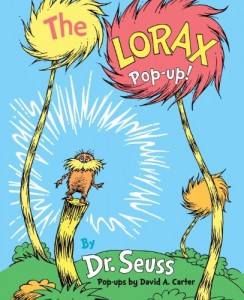 As with all of the Dr. Seuss books that I have adapted, I felt it was important to keep true to the feel and concept of the the original book. We did not edit the text and we used as much of the original illustration as possible. The fact that the film was in the works influenced the publishing of the pop-up version, but as you can see, the film did not influence the treatment I used for the pop-up.
As with all of the Dr. Seuss books that I have adapted, I felt it was important to keep true to the feel and concept of the the original book. We did not edit the text and we used as much of the original illustration as possible. The fact that the film was in the works influenced the publishing of the pop-up version, but as you can see, the film did not influence the treatment I used for the pop-up.
You’ve done a Seuss pop-up before—HORTON HEARS A WHO—but what new challenges did you come across with THE LORAX POP-UP?
The biggest difference between the LORAX POP-UP and the HORTON is that because of an increase in the cost manufacturing, we had to reduce the complexity of the paper engineering in THE LORAX.
How do you determine which part of the illustrations will “pop” from the page and which will remain flat?
The beauty of Dr. Seuss’ work is that, even though the drawings are two dimensional, they have a stupendous amount of dimension and movement, which makes my job easy. The problem was not what to make pop-up or move, but what I had to leave two-dimensional.
I read that Dr. Seuss’ books were some of your favorite books during your childhood years. What is it about Dr. Seuss and his stories that you enjoy so much? Add a Comment
Blog: The Children's Book Review (Login to Add to MyJacketFlap)
JacketFlap tags: David A. Carter, Environment & Ecology, Ages 4-8, Dr. Seuss, Interactive, Gift Books, Add a tag
Reading level: Ages 3-8
Add this book to your collection: The Lorax Pop-Up! by Dr. Seuss
Video courtesy of RandomBooks: “Dr. Seuss’s well-known and well-loved The Lorax is as timely now as it was when it was first published in 1971—perhaps even more so. This bestselling ecological warning is now available in an elaborate pop-up book, published in conjunction with the release of The Lorax feature film on March 2, 2012—Ted Geisel’s birthday.
David Carter has transformed Seuss’s powerful message and has brought to life the Lorax, the Bar-ba-loots, the Truffula Tree Tufts—and more—in eight dynamic pop-up spreads.”
Learn more: http://www.randomhouse.com/kids/catalog/display.pperl?isbn=9780375860355
©2012 The Childrens Book Review. All Rights Reserved.
. Add a CommentBlog: The Children's Book Review (Login to Add to MyJacketFlap)
JacketFlap tags: Ages 4-8, Picture Books, Nature, Science, Biology, Water, Books for Girls, Animal Books, Marine life, Jason Chin, Environment & Ecology, Add a tag
By Nina Schuyler, The Children’s Book Review
Published: January 27, 2012
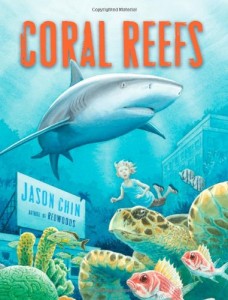 Coral Reefs
Coral Reefs
By Jason Chin
Reading level: Ages 5 and up
Hardcover: 40 pages
Publisher: Flash Point (October 25, 2011)
Source: Publisher
What to expect: Science, Nature, Biology, Marine life, Water
Jason Chin does something pretty wonderful in his nonfiction book, Coral Reefs: He hasn’t forgotten the wild imagination of a kid.
What makes Coral Reefs unique is that along with loads of interesting information, he’s included colorful watercolor illustrations that tell their own story. In a sense he is blurring the boundary between fiction and nonfiction. The result is something completely engaging. And this hybrid form dishes out just enough facts without overwhelming. So you learn that though coral reefs may look like plants, they’re actually animals; and at the same time, the pictures, which often take up more than half the page, tell the story of a girl who goes to the library and picks up a book about coral reefs.
You learn coral reefs are the largest structures built by an animal on earth! The Belize barrier reef is over 180 miles long!; and at the same time, the illustrations show the girl’s world transforming, with the library slipping away and turning into coral, along with sea plants and fish. “There are so many species living in reefs that they are often called the cities of the sea,” writes Chin. And the water whooshes into the library, and the girl is swept up on a wave that carries with it octopus, sea turtles, fish and more coral. Very quickly, the girl is floating underwater, exploring and learning about the city of the sea. It’s a city, Chin tells us, with “a complex web of relationships, and each has its own place in the system.”
“There are so many species living in reefs that they are often called the cities of the sea,”
After you’ve fallen in love with coral reefs and the teeming life that calls it home—“More than four thousand kinds of fish and thousands of other species have been discovered in coral reefs—more than in any other part of the ocean”—after he’s completely hooked you, Chin has bad news. The reefs, just like so many other living things, are threatened by pollution and over-fishing. Thankfully, he gives a list of things you can do to help. You can—and you’ll want to—form a relationship with the reefs.
Add this book to your collection: Coral Reefs
Nina Schuyler‘s first novel, The Painting, (Algonquin Books of Chapel Hill/2004), was a finalist for the Northern California Book Awards. It was also selected by the San Francisco Chronicle as
Add a Comment



